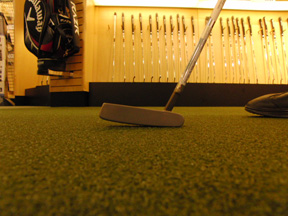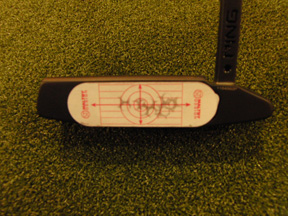Putter Fitting
By John Green
While my friend Chris Foley just discussed getting fit for the driver so you can hit it farther, the “short of it” topic this month is about getting fit for a club that can reduce your score. I highly recommend you get fitted for this all-important scoring club.
Here are four questions that you need to ask (or have been asked if you were fitted) when going through a putter fitting and the reasons behind them:
Is my putter the correct length for me?
Having the correct length of the putter is very important as it influences distance, direction, and consistency in both the stroke and set-up at address.
What loft do I need?
Loft by itself is a very important function of distance control. Since we putt on grass and not a hard surface like concrete, the ball settles down in the grass on the green. When you putt, loft is needed to get the ball out of its depression in the grass. The ball will then skid a bit because it was lifted out of the depression, and then it rolls. If there is little to no loft, the ball won’t be lifted up out of its depression and the ball will bounce, resulting in a lack of distance control.
Is the lie important, and does my putter need to set flat on the ground at address?
Lie of any club is all about where the clubface is pointing at impact. Therefore lie has a major impact on the direction of the ball. In this photo, where it shows the putter’s toe is in the air, the face is actually pointing a little left of the target. It is always recommended the sole of the putter should lie flat on the ground so the face will be pointing to where you are aiming. The key here is the putter needs to be adjusted to how you set up, rather than you adjusting to the putter’s set up.
Is swingweight important with putters?
To put it in its most basic terminology, swingweight is simply how the weight of the head feels. And thus, it has an influence on distance control. If the swingweight of a putter is too light, the golfer may have less “head feel” and the balance of the putter may be off. (This is a common occurrence when a putter is shortened) On the other hand, some of today’s putters are counterbalanced with a substantial amount of weight under the grip. This weight under the grip reduces the head feel and this is why new counterbalanced putters have significantly heavy heads than traditional putter heads. If you choose to counterbalance your putter, lead tape may need to be applied to the head to increase the swingweight of the putter.
Am I using a putter that is right for me?
The best test to see whether your putter is right for you is to hit five or six putts of eight to ten feet with some impact tape on the face to see where your contact is. If the resulting impact marks are similar to the above picture, you will need a putter with more forgiveness for these off-center hits. Larger putter heads tend to be more forgiving on those miss-hits because they have more weight in the heel and toe of the putter. This weight distribution will help the putter twist less on off-center hits. If your fitter mentions “MOI” when discussing putters, this word means “Moment of Inertia”. And MOI simply means the amount of twisting the putter head makes on off-center hits. More MOI = More Forgiveness.































